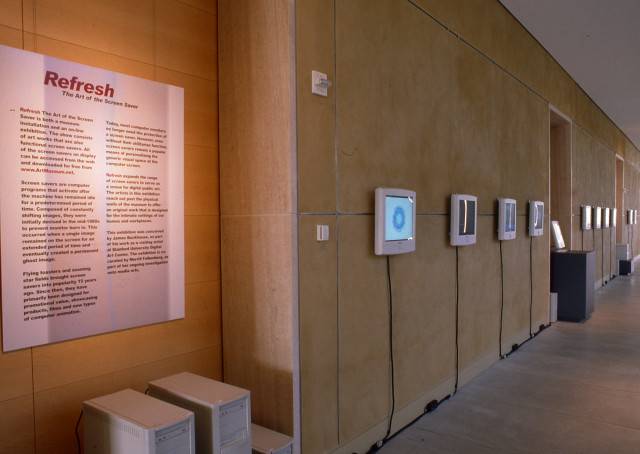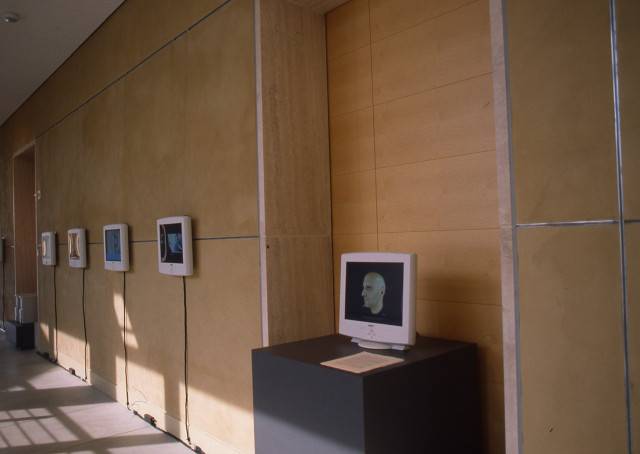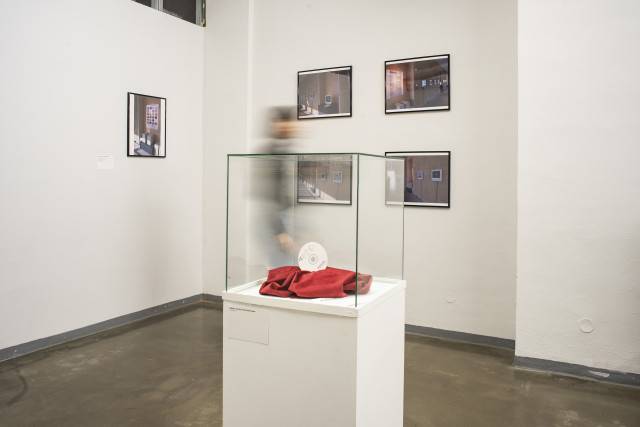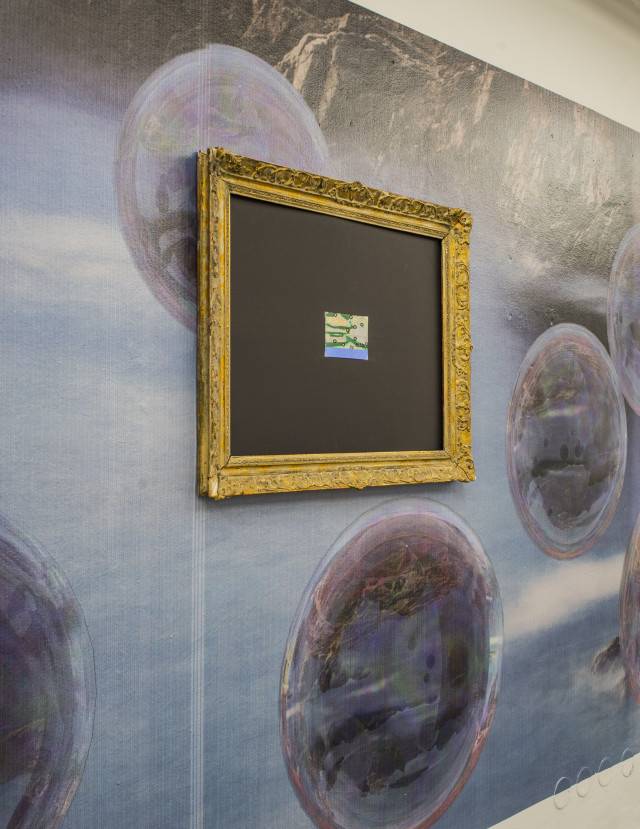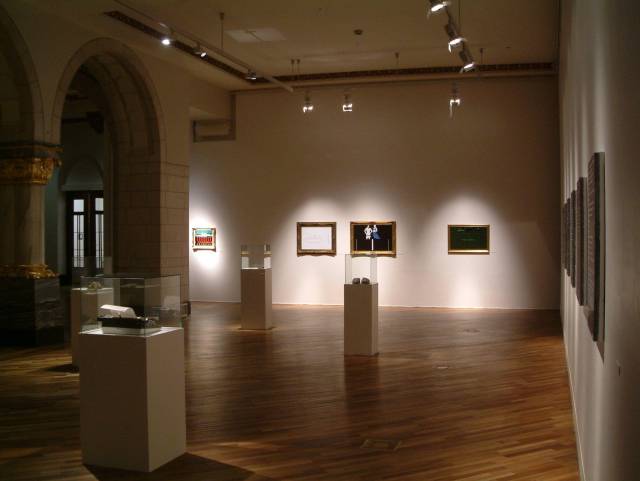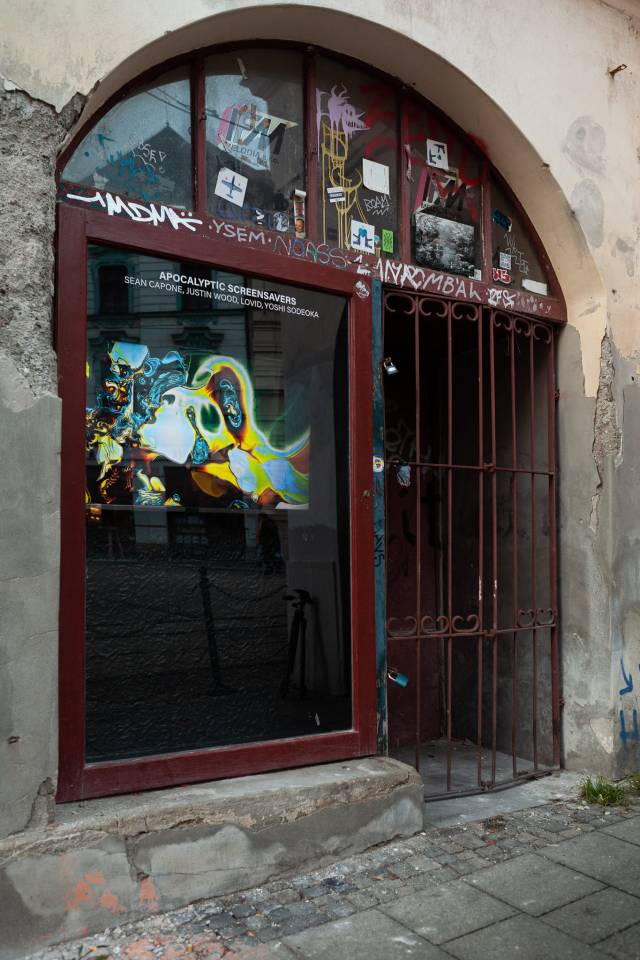New Media Museums Proceedings, 2022
Preparing a Historical Exhibition of Screensavers
Introduction
The following text deals with the exhibition Screensaver as a Unique and Shocking Artform created within the New Media Museums project in cooperation with PAF, ScreenSaverGallery and Galerie XY in Olomouc. It built on several, from our point of view essential, exhibition activities that dealt with the computer screensaver as a distinct artistic entity, whose traces in cultural memory are slowly disappearing.
But how to credibly approach something as ephemeral as a screensaver in a gallery space, which conditions a completely different way of perception than the native screensaver environment of idle moments in the middle of work on one's computer? Especially when they are no longer functional in their original form, for example, due to the discontinuation of support for the obsolete Flash format,1) and in many cases their documentation is not available?
Fig. 1: Exhibition detail of Screensaver as a Unique and Shocking Artform, Galerie XY, Olomouc, 2021-2022.
Fig. 2: Exhibition detail of Screensaver as a Unique and Shocking Artform, Galerie XY, Olomouc, 2021-2022.
Screensaver as an artwork
A screensaver is a computer program that was originally designed to protect computer screen or monitor from permanent damage caused by viewing static images for long periods of time. From the perspective of its user (the viewer), a screensaver appears as a moving image - most often a simple form of animation running on the computer screen during moments of inactivity. They had their heyday in the 1990s. Since the latter half of the 2010s, when more sophisticated technology pushed CRT monitors out of the market, they have been labelled an obsolete medium.
At a time when screensaver roles were primarily practical, their creators were primarily programmers. While the screensaver has lost importance as a medium in terms of functionality, it has regained importance as it is used in educational works, digital art galleries and also as stand-alone artworks.
Although it no longer serves to protect the screen, it retains its basic formal characteristics. Works created for the computer screensaver have some specificities resulting from this medium:
- It is time-based. It unfolds linearly in time, like film and music. It cannot be consumed in a single moment or at its own pace like a photograph or a painting;
- It's not interactive. It cannot be sped up, skipped forward or rewound;
- It has no real ending or beginning. Screensaver lacks a linear story. It either generatively unfolds in time, or takes the form of a loop or static image (even if the video is presented as a screensaver).
Moreover, its reception is linked to a specific context:
- The screensaver addresses its viewer only in moments of inactivity, i.e. when the viewer is not using a computer and is usually resting from work. These moments may seem ideal for taking in, appreciating, and contemplating art.
- The reception is usually held in a private setting (study, bedroom, children's room, etc.);
- However, it can also take place in a public space, on publicly accessible computers, for example in libraries and school classrooms (but also on personal laptops where the screensaver is triggered in moments of user inactivity, for example in a café or on a train), creating interesting stimulating situations for casual observers, especially if the work has a sound component.
The term screensaver, as seen and used in this text, refers to both a computer program, i.e. a medium or container, and its specific audiovisual content.
Preparing an exhibition for XY Gallery Olomouc
The screensaver is still a basic piece of software on all computers, although its practical purpose (protecting the screen from damage) has completely disappeared with modern monitors. Throughout history, a number of fascinating art projects have been created for this specific medium, which have been the subject of several exhibitions from 2000 to the present day. The exhibition Screensaver as a Unique and Shocking Artform was a modified reiteration of these historical exhibition realizations.
The basis of the exhibition, which occupied the entire upper floor of the XY Gallery in Olomouc, was the exhibition Refresh: The Art of the Screensaver (2000) curated by artist James Buckhouse with Merrill Falkenberg.2) The Refresh exhibition was realized both online (on the ArtMuseum.net website) and in a physical gallery space (the Iris & B. Gerald Cantor Center for Visual Arts at Stanford University in Stanford, California).
Traces of perhaps the first exhibition of computer screensavers in an artistic context, Refresh: The Art of the Screensaver has been buried deep in the Internet Archive. Here we discovered the exhibition website with tiny images (typical of turn-of-the-century websites). The only surviving documentation of the installation appears to be one small, blurry jpeg with barely distinguishable content, 19.2 kB in size and 72 dpi resolution. And yet it is very telling and valuable; the only publicly available image documentation of a possibly crucial exhibition of computer screensavers in physical space. However, in communicating with Shanna Dickson, associate registrar of the permanent collection at the Cantor Arts Center, we were able to earmark additional documentation: several photographs taken not by a professional photographer, but by a museum staff member. The photographs provided us with information about the technology (hardware) used for the installation at the time and the spatial setting of the exhibition.
Fig. 3: Exhibition view of Refresh: The Art of the Screensaver, Iris & B. Gerald Cantor Center for Visual Arts, Stanford University, 2000.
Although the online part of the exhibition was supposed to last “indefinitely,” it is missing from its original location. The original accompanying texts can still be read at the Internet Archive,3) but it is not possible to download and run screensavers. The exhibition's website was created by New York-based network artist Yael Kanarek and powered by Intel Corporation, which owns the copyright to the site's web framework and format elements.4) Fortunately, Kanarek still had the original CD of the exhibition files and a physical printed poster, which she was willing to share.5) Tomáš Javůrek, the technologist behind ScreenSaverGallery, was able to reconstruct the files. They were first shown online, in the original context of the computer screensaver as an exhibition at ScreenSaverGallery6) and in the physical exhibition space (white-cube) of Gallery XY.7)
Fig. 4: Exhibition view of Refresh: The Art of the Screensaver, Iris & B. Gerald Cantor Center for Visual Arts, Stanford University, 2000.
We had to contact the curators of Refresh not only for permission to use their selections, but also because many of the artworks were not originally screensavers, but other types of art forms: paintings, videos, or even documentaries, and turned into screensavers.8) In all cases, we had to contact the artists or their gallery representatives to get their permission to present the work on/off-line and to reconstruct the original form or meaning of the work. I was unable to reach Mick and Ted Skolnick in any way, and many of the artists are now represented by galleries, making communication difficult. For example, for Francis Alÿs' work, I obtained permission from Dia:, who commissioned the original work, but could not get any response from David Zwirner Gallery, who now represents the artist. The three screensavers could not be reconstructed and were presented as static images with explanatory captions in an online exhibition and as printed and framed photographs in the gallery after discussion with their artists. Alexander R. Galloway's EveryImage (2000) was originally a server-based work, downloading images in real time from the Rhizome database. cameraSS (2000) by the duo Entropy8Zuper was an online performance containing a live stream from a webcam that would need to be re-performed. However, the context of computer use is now quite different (and there was no time or resources to do so). SoftSub (1999), a screensaver from C5, was developed in the Mac Classic environment using Flash. These archival issues are now being addressed by the University of San Jose to include C5's work in its permanent collection. Flash-based artworks, such as Yael Kanarek's World of Awe (2000), were run on a virtual machine and recorded and then played back as video.
Kanarek described the atmosphere of the effort to preserve obsolete digital works as follows:
“I tried to work with curator Kerry Doran on an initiative to preserve World of Awe, but they couldn't find resources in the US for this kind of work. In addition to my own work, I founded and led the Upgrade! International for ten years with the support of Eyebeam. I've done various projects with Rhizome and created websites that supported networked art initiatives, including a legacy site for Whitney Artport. Most of the physical and digital artwork has been saved, as well as the old computers that are still functional (fingers crossed). I recently lost some important works due to a lightning interruption. It hurts a lot. I'm writing this cautiously, trying to feel the waters. The sum total of these creative endeavors seems to offer a timestamp of technological aesthetics, net art, and digital art from 1995-2006ish in New York and beyond.”9)
Exhibition design
Fig. 5: Exhibition view of Screensaver as a Unique and Shocking Artform, Galerie XY, Olomouc, 2021-2022. Photo: Barbora Trnková.
Fig. 6: Exhibition view of Screensaver as a Unique and Shocking Artform, Galerie XY, Olomouc, 2021-2022. Photo: Barbora Trnková.
Fig. 7: Exhibition view of Screensaver as a Unique and Shocking Artform, Galerie XY, Olomouc, 2021-2022. Photo: Barbora Trnková.
The screensavers in the online ScreenSaverGallery were presented randomly and in a loop, and each of them was labeled (artist, title, year). It was more challenging to show them in the physical space of Gallery XY. The original technology would have been impossible to obtain under the conditions we had available, so the screensavers ran as videos on a modern monitor, which only minimally and humorously referred to the original solution by its arrangement in space and the inclusion of two “obsolete” PC cases as objects on which the monitor stood. All the screensavers were presented on a single screen, behind each other, unlike in the original exhibition where each had its own space. In contrast, the vertical walls were used to present an interactive screen with the original exhibition website (Yael Kanarek files), photographs of the installation obtained from the Cantor Arts Center, and an xeroxed poster/CD booklet.
Those screensavers that could no longer be reconstructed, despite all efforts, we decided, with the knowledge of their authors, to exhibit using a strategy that references another important digital art exhibition, Written in Stone: A Net.art Archaeology. This was a net.art exhibition curated by Per Platou for the Museum of Contemporary Art in Oslo in 2003.10) His exhibition strategy very originally (and quite successfully) solved the problem of how to present intangible, interactive and rapidly obsolete web-based work in physical space. The key was the exaggerated glorification and seemingly bizarre “objectification” of digital works - presenting them as material objects, or through material objects closely related to the work or its creator. In doing so, Platou presented the spirit/concept/expression of the work better than if he had shown the work itself in the white-cube space (i.e. in a completely different environment than the one for which it was intended).
Fig. 8: Exhibition view of Written in Stone: A Net.art Archaeology, Museum of Contemporary Art, Oslo, 2003.
In gilded frames, marked by time and scratching, photographs of unreconstructible savers were bizarrely brilliant on a black passepartout. The resolution that twenty-two years ago took up an entire computer screen is now barely sufficient for a tiny digital print the size of the once-popular analogue photography formats. Our installation solution included a glass display case and an object on red velvet - the original CD containing the historical files, exhibiting the screensavers in their original form. Throughout the installation, the contradiction of new and old technologies was emphasized, all of which appear equally fragile and imperfect, and which are destined to become obsolete at the moment of their birth. The expensive large-format colour print, printed directly onto the wall by a vertical printer, failed technologically in its precision and flawless execution. It remains unfinished, the lines don't fit, the paint flakes off.
The entire exhibition in Gallery XY was crowned (or opened) by a mirrored 3D (Windows-screensaver-like) inscription with the exhibition title printed with modern technology directly on the wall, reflected in the entrance corridor filled with mirrors. Perhaps the black mirror of the computer screens evokes for the viewers the impossibility of accurately viewing the period savers through the perspective given by the “mirror of time.” As with many screensavers, this is a purely aesthetic solution.
In the case of the exhibition Screensaver as a Unique and Shocking Artform, the aim was not to reconstruct the exhibition Refresh: The Art of the Screen Saver one-to-one in its original form, but rather to bring it closer through the documentation of its contemporary form and the presentation of fragments of the works in their preserved form with the necessary commentary (whether explicitly through a description, curatorial text, or through the dramaturgy of the space or the presentation of other projects to complement the exhibition). Thus, the 'translation' of the exhibition into a gallery (Central European) environment. This also applied to the following three projects presented on the lower floor of the gallery, which complemented the exhibition as a whole.
Interactive archives of Idle Screenings and ScreenSaverGallery
In the 2010s, two contemporary digital art galleries dedicated to screensavers were born independently of each other: Idle Screenings (2012-2015) and ScreenSaverGallery (2013-present). Starting from different motivations and illustrating different approaches to the medium, they nevertheless stand partly on common ground. Both are the work of internet artists (Jacob Broms Engblom and Mitch Trale - Idle Screenings, Barbora Trnková and Tomáš Javůrek - ScreenSaverGallery) and both galleries were originally created as net-art works.
In our exhibition, visitors could browse the archive of artworks (screensavers) presented in these galleries on computers on the lower level of the gallery, and run and view individual exhibitions at will. They could then install the ScreenSaverGallery (app) from the website screensaver.gallery; and view the current spin-off exhibitions at Gallery XY, namely the reconstructed screensavers from another website.11)
Again, we communicated with both the gallerists and the authors of the individual works. The digital data for their presentation was supplied by the former curators of Idle Screenings and ScreenSaverGallery from their own archives.
Tablets with documentation materials of recent exhibitions and projects
Fig. 9: Exhibition view of pocalyptic Screensavers, Vitrína Deniska, Olomouc, 2021-2022. Photo: Tomáš Jakubec.
In the corridor connecting the two exhibition spaces on the lower floors of the gallery, a number of tablets were placed, presenting documentary (often diy) materials of recent projects dealing with screensavers in the context of contemporary art. For the exhibition halls of the Het Nieuwe Instituut in Rotterdam, the digital artist Rafaël Rozendaal prepared a large-scale exhibition of classic screensavers Sleep Mode. The Art of the Screensaver (2017). An unprecedented and daring project are two commercial virtual reality products from the Los Angeles-based studio FLOAT LAND: Screensavers VR 1.0 and Screensavers VR 2.0 and Evening Dreams (both launched in 2019).12) Their users can find themselves inside the all-enveloping canonical screensavers of the 1990s and 2000s - and get lost in reading studies on screensavers from the likes of Joanne McNeil, D. S. Chun, Steve F. Anderson, Mark America, Bill Stewart, and others. The essays are also currently being prepared for book publication. The online exhibition screensaver watching you, curated by Pita Arreola-Burns and Elliott Burns, took place in 2020 on the Off Site Project online gallery website. 13) The selection of works and the design of the website was inspired by the legacy of screensavers and the haunting nature of our digital devices and what lies beyond the surface of the screen. The Apocalyptic Screensavers exhibition was realized in 2020 in Queens, New York, at a smaller art gallery called 5-50. It presented videos and prints by American digital artists Sean Capone, Justin Wood, Yoshi Sodeoka and the group LoVid. Instead of official documentation, only a walk-through video of the opening night is available, as the exhibition closed early due to covid. The theme of the screensaver - as a kind of algorithmic wallpaper on a digital screen - is used to celebrate the allure of pure decorativeness, the almost brazen joy of the artistic process, and the phantasmagorical and hypnotic environments appearing on the computer screen we currently inhabit (i.e. a counterpoint to interior wallpaper or murals). The video part of the exhibition was shown at Vitrína Deniska in Olomouc from 19 December 2021 to 20 March 2022.
Projection with period screensavers
In the outermost spaces of the lower floor, the viewer encountered an improvised large-format projection that was meant to remotely evoke the exhibition Sleep Mode. The Art of the Screensaver, contrasting the expensive and accomplished installation in a high-budget institution with the intimate domestic conditions. A selection of the greatest classics recalls the five screensavers for Windows: Mystify, Starfield, Maze, 3D Pipe and 3D Text. Perhaps the impression of something as ephemeral (hence “crumbling under the hands” over time) as the screensaver itself has been metaphorically achieved.
Conclusion
We have chosen to reiterate (i.e. “re-present”, repeat) the exhibitions (or re-present the exhibited works), which we have modified in such a way that the original form of the given exhibition is clearly understandable and at the same time it is possible to present the works under the current technological conditions. We have included historical documentation of the exhibition Refresh: The Art of the Screen Saver, which forms the core of our exhibition project, so that the form of the screensaver and its evolution as an art form over time, as well as the form of the original installation, are understandable to viewers. The screensavers for the exhibition had to be first found and then reconstructed from the original files, but the recovery of some files and their presentation was no longer possible. In these cases, available contemporary documentation (screenshots, etc.) was used, accompanied by a caption to give an idea of the original form of the work.
For a better understanding, the exhibition was supplemented by the context of the exhibition's treatment of the screensaver as an art form in an artistic context - a fragmentary approach to several other projects and exhibitions. It was also expanded by the realization of the exhibition The Limits of ScreenSavers_A SCRAVER AS A UNIQUE AND SHOCKING ART FORM in an online space, where it was possible to explore the individual screensavers in their original environment, the interface of a personal computer screen, however, insistently marked by a technological barrier (the transformed standard of resolution over the past twenty years, the impossibility of playing the work as such, only its (video) recording, or the impossibility of re-editing individual works), and by a fragment of the Apocalyptic Screensavers exhibition in the Deniska showcase in Olomouc, where the video part (i.e. without physical large-format digital prints) of the New York exhibition dedicated to the “screensaver works” of contemporary digital artists was re-introduced. As a whole, it was thus possible to approximate a certain period feeling of several exhibitions.
